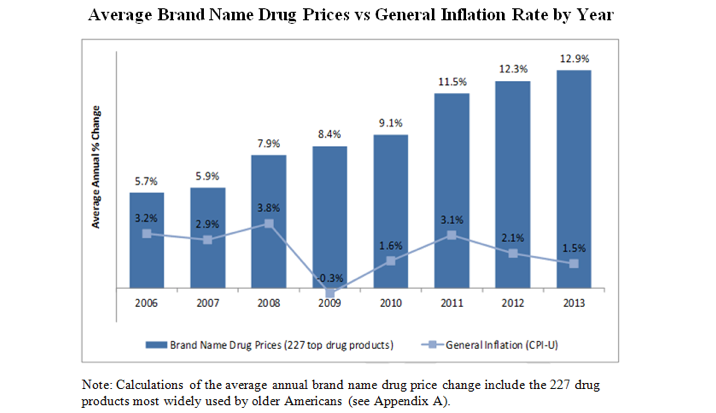Article
Brand-Name Rx Drug Costs Rose 13% in 2013
Author(s):
The prices for brand-name prescription medications commonly used by older adults increased by an approximate average of 13% last year, more than 8 times faster than the general inflation rate.
The prices for brand-name prescription medications commonly used by older adults increased by an approximate average of 13% last year, more than 8 times faster than the general inflation rate, according to an AARP report. It is the highest annual average cost increase for brand-name drugs since AARP began tracking this type of prescription data a decade ago.
According to the report, retail costs for the top 227 brand-name prescription drug products taken by older adults increased by 12.9% on average in 2013, while the general inflation rate increased by only 1.5%. By comparison, the prices of those drugs increased by 12.3% in 2012, relative to a 2.1% inflation rate.

In 2013, retail prices increased for 97% of the top 227 brand-name prescription drugs, a handful of which had average annual cost increases greater than 30%, including:
- Uroxatral 10 mg tablet ER (197.5%)
- Actonel 150 mg tablet (78.6%)
- Solaraze 3 percent gel (67%)
- Prandin 2 mg tablet (38%)
- Lunesta 2 mg tablet (34%)
- Aciphex 20 mg tablet DR (32.2%)
- Welchol 625 mg tablet (30.6%)
“Higher brand name drug prices can increase health care premiums, deductibles, and other cost-sharing for everyone with health coverage, even for those who don’t take medications,” said AARP Executive Vice President for Policy, Strategy, and International Affairs Debra Whitman in a press release. “If these price increases continue, we’ll likely see more people—particularly older people, who are often on fixed incomes—stop taking life-saving medications because they simply can’t afford them, leading to higher health care costs down the road.”
About two-thirds of older Americans take 3 or more prescription drugs in a given year. If those medications were brand name, their drug costs could be estimated at more than $8800 in 2013 alone, more than double the estimated cost for medications seen less than a decade ago.
The AARP report pointed out that these price increases lead to higher out-of-pocket costs for patients who pay a coinsurance instead of a fixed dollar amount. The AARP fears adults will stop taking these medications simply because they can’t afford them.
“The relentless rise in brand-name drug prices also has implications for taxpayer-funded programs like Medicare and Medicaid,” Whitman explained. “Higher government spending driven by large price increases eventually affects all Americans in the form of higher taxes, cuts to public programs, or both.”





